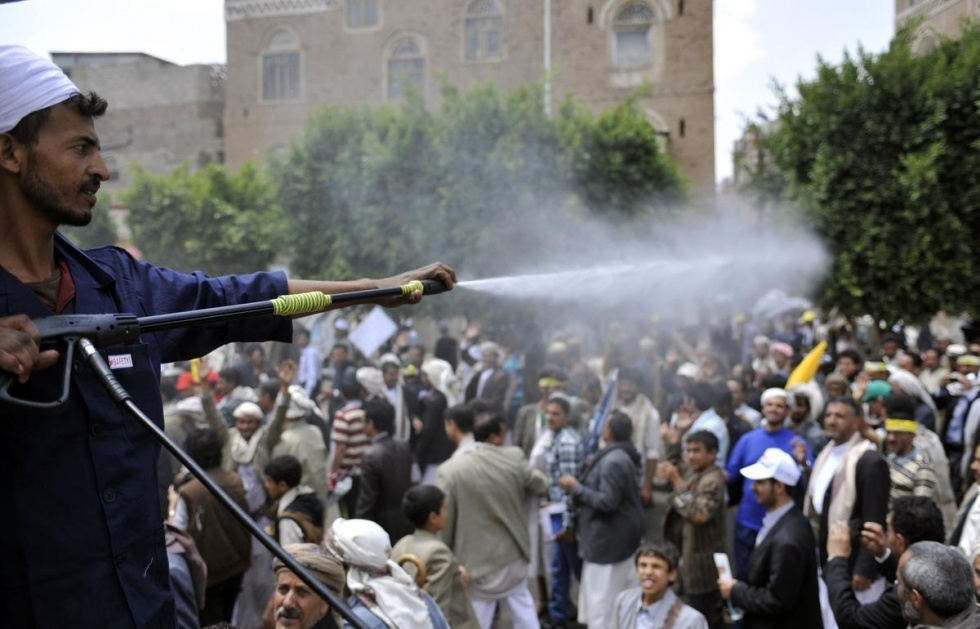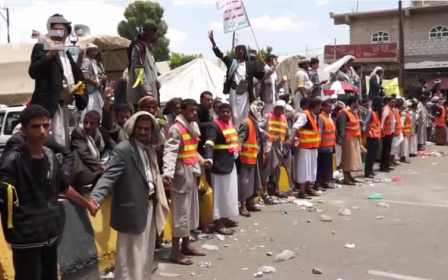Further protests rock Yemen as conflict reaches boiling point

There were further clashes between Houthi rebels and Yemeni security forces in the capital on Wednesday, just one day after a bloody crackdown killed seven protesters.
Wednesday’s clashes occurred in the Sana’a suburb of Sabaha, where protestors have been camped out for weeks in a campaign to bring down what they see as a corrupt government, end a controversial increase in fuel prices and secure greater representation within state institutions.
There were also clashes between protestors and security services near Sana’a international airport.
As reserve troops were called up, President Mansour Hadi visited troops at a military base just south of the capital.
He wore a military uniform for the first time since he acceded to power in 2012, according to Anadolu.
As the security situation in the capital continues to deteriorate, toppled former president Ali Abdullah Saleh fled his central Sana’a home for an outlying area of the governorate, according to Yemeni news site, Yemen Now.
However, Yemeni media outlets were awash with reports that Jalal al-Beleidi, leader of al-Qaeda in Yemen, had been seen in Sana’a after a long absence.
Outside the capital, four armed Houthi rebels were killed and three tribesmen were injured during clashes in the northwestern province of al-Jawf.
On Tuesday, seven activists were shot dead as Houthi protesters reportedly attempted to storm government headquarters, while thousands blocked main thoroughfares in central Sana’a.
There were reports that unarmed protestors were shot by snipers who were placed on rooftops near the march, while Baraa Shiban, an activist working with anti-torture charity, Reprieve, reported seeing two bodies of protestors, who had died from direct gunshot wounds to the head.
Amnesty International condemned the killings, saying they “heightened fears that the current confrontation there will escalate into a full-blown conflict.”
The organisation called on the Yemeni authorities to respect the right to peaceful protest and “refrain from using excessive force to disperse demonstrations.”
Graphic footage broadcast by Houthi-run television channel al-Masira - one of whose cameramen was injured in the shootings - appears to show uniformed troops firing on demonstrators as they wave white flags. The video could not be independently verified.
However, Yemeni authorities denied that army troops were responsible for the deaths, and alleged that soldiers had been among the dead.
Yemen’s Supreme Security Committee announced that “a number of soldiers and Houthi protestors were killed,” alleging that the shots were fired by “armed persons in the area, as well as from among the protestors themselves.”
Also on Tuesday, troops in Hiziaz - a southern entrance to Sana’a - clashed with rebels who tried to drive a vehicle loaded with arms into the capital.
A civilian was killed and 15 others wounded in the confrontation, according to Yemen's top security commission, adding that several police and soldiers were also wounded.
It accused rebels of firing machine-guns and rocket-propelled grenades.
Houthi rebels have so far rejected overtures from President Abdrabuh Mansur Hadi, who has offered to name a new prime minister and reduced a disputed fuel price hike.
Both concessions were core demands of the Houthis, who launched protests on 18 August, after battling loyalist forces for months for control of key cities north of Sana’a.
Though President Hadi has reduced fuel prices slightly, Houthis demand the return of prices to their pre-2011 levels, before Arab Spring revolts toppled the government and started a long process of political transition in the country.
Analysts speculate that rebels could be attempting to become a top political force in the majority-Shiite northern highlands of Yemen, close to the country’s border with Saudi Arabia.
Video credit: Yousef Mawryy
New MEE newsletter: Jerusalem Dispatch
Sign up to get the latest insights and analysis on Israel-Palestine, alongside Turkey Unpacked and other MEE newsletters
Middle East Eye delivers independent and unrivalled coverage and analysis of the Middle East, North Africa and beyond. To learn more about republishing this content and the associated fees, please fill out this form. More about MEE can be found here.




